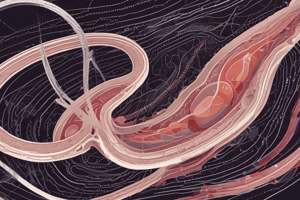Podcast
Questions and Answers
What is spermatogenesis?
What is spermatogenesis?
It is the process by which mature motile spermatozoa are produced.
When does spermatogenesis begin?
When does spermatogenesis begin?
It begins at puberty.
Where does spermatogenesis occur?
Where does spermatogenesis occur?
In seminiferous tubules of the testis.
How long does spermatogenesis take?
How long does spermatogenesis take?
At birth, germ cells in the male infant testis can be recognized as ______ cells surrounded by supporting cells.
At birth, germ cells in the male infant testis can be recognized as ______ cells surrounded by supporting cells.
Match the stages of spermatogenesis with their descriptions:
Match the stages of spermatogenesis with their descriptions:
What occurs during the stage of transformation (spermiogenesis)?
What occurs during the stage of transformation (spermiogenesis)?
What are the structures of sperm?
What are the structures of sperm?
Which hormones regulate spermatogenesis?
Which hormones regulate spermatogenesis?
Where is luteinizing hormone (LH) produced?
Where is luteinizing hormone (LH) produced?
What is the function of LH in spermatogenesis?
What is the function of LH in spermatogenesis?
Why is follicle stimulating hormone (FSH) essential?
Why is follicle stimulating hormone (FSH) essential?
What percentage of spermatozoa may have observable defects?
What percentage of spermatozoa may have observable defects?
What are the types of abnormalities in sperm?
What are the types of abnormalities in sperm?
What is the normal semen volume?
What is the normal semen volume?
What is the normal pH of semen?
What is the normal pH of semen?
What is the normal liquefaction time for semen?
What is the normal liquefaction time for semen?
What is the normal sperm count per ejaculate?
What is the normal sperm count per ejaculate?
What is considered normal sperm morphology?
What is considered normal sperm morphology?
Flashcards are hidden until you start studying
Study Notes
Spermatogenesis Overview
- Process of producing mature, motile spermatozoa.
- Begins at puberty and continues into old age.
- Occurs in the seminiferous tubules of the testis.
- Total duration approximately 60-64 days.
Stages of Spermatogenesis
- Stage of Proliferation:
- Primordial germ cells develop into type A spermatogonia (2n).
- Type A undergo mitosis to form clones and ultimately produce type B spermatogonia (2n).
- Stage of Growth:
- Type B spermatogonia develop into primary spermatocytes (2n).
- Stage of Maturation:
- Primary spermatocytes undergo meiosis I to form secondary spermatocytes (n).
- Secondary spermatocytes divide to form haploid spermatids (n).
Spermiogenesis
- Transformation of spermatids into spermatozoa includes:
- Formation of the acrosome containing enzymes for fertilization.
- Condensation of the nucleus.
- Development of the neck, middle piece, and tail.
- Shedding of excess cytoplasm, phagocytized by Sertoli cells.
- Maturation takes about two months; spermatozoa move to the lumen of seminiferous tubules and are transported to the epididymis for full motility.
Sperm Structure
- Head: Contains acrosome and nucleus.
- Neck: Houses centrioles.
- Body: Middle piece loaded with mitochondria.
- Tail: Comprises axial filaments.
Hormonal Regulation
- Luteinizing Hormone (LH):
- Produced by the pituitary.
- Stimulates testosterone production from Leydig cells, enhancing spermatogenesis.
- Follicle Stimulating Hormone (FSH):
- Also produced by the pituitary.
- Promotes testicular fluid production and testosterone receptor synthesis in Sertoli cells.
Sperm Quality and Abnormalities
- Up to 10% of spermatozoa may exhibit observable defects.
- Types of abnormalities include:
- Anomalies in head or tail structure.
- Giant or dwarf spermatozoa; occasionally joined sperm.
- Morphologically abnormal sperm may lack motility and fertilization capability.
Semen Analysis Parameters
- Normal Semen Volume: 2ml or more (2-4 ml typically per ejaculation).
- Semen pH: Ranges from 7.2 to 8.0.
- Liquefaction Time: Approximately 20-30 minutes post-collection.
- Sperm Count: 40 million or more spermatozoa per ejaculate.
- Sperm Morphology: At least 30% of sperm should have normal shape and structure.
Studying That Suits You
Use AI to generate personalized quizzes and flashcards to suit your learning preferences.




